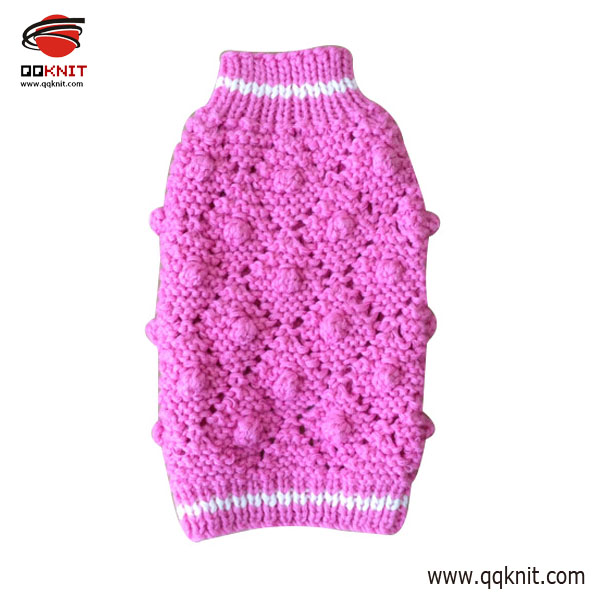QQKNIT applying the wisdom of the "Jie Gua" from the Book of Changes to the activity of hand knitting dog sweaters provides practical and philosophical insights. Here are some detailed thoughts and application suggestions that combine the ideas of both:
1. Moderation and Balance
**Planning and Design:**
- Time Management: Allocate specific times for knitting to avoid burnout and ensure a steady progress.
- Material Usage: Plan the amount of yarn and materials needed before starting to avoid wastage. Opt for designs that are both aesthetic and functional without being overly complex.
- Balanced Design: Incorporate elements that enhance the sweater's look while ensuring it remains comfortable for pets. Avoid excessive decoration that could make the handmade sweater bulky or uncomfortable.
2. Innovation and Stability
**Hand Knit Skill Development:**
- Basic Skills: Continuously practice and refine basic hand knitting techniques to maintain a strong foundation.
- Controlled Innovation: Experiment with new designs and techniques in a way that complements the basic skills. For example, try incorporating simple yet effective patterns or using a mix of traditional and modern knitting methods.
- Quality Control: Ensure that any new techniques or designs maintain the quality and durability of the handmade sweaters.
3. Timely Adjustment and Self-Reflection
**Flexibility in Process:**
- Material Management: Be prepared to adjust designs based on material availability. If a particular yarn runs out, find a suitable alternative that complements the design.
- Design Adjustments: Adapt the design if the initial plan doesn’t work out as expected. For example, if a complex pattern is too time-consuming, simplify it without compromising the overall aesthetic.
**Self-Reflection:**
Regularly evaluate your work to identify areas for improvement. Keep a journal to document challenges faced and solutions found, which can be useful for future projects.
4. Frugality and Resource Utilization
**Sustainable Practices:**
- Eco-Friendly Materials: Choose sustainable and eco-friendly yarns that are gentle on the environment.
- Efficient Use of Materials: Calculate the exact amount of yarn needed for each project to avoid excess. Use leftover yarn for smaller projects or as accents in other designs.
- Practicality and Aesthetics: Focus on creating sweaters that are both functional and visually appealing. Avoid luxury materials that do not add significant value to the comfort or durability of the hand knit sweater.
5. Starting from Reality and Adapting Flexibly
**Realistic Planning:**
- Size Adjustments: Regularly measure your pet to ensure the handmade sweater will fit properly. Adjust patterns as needed to accommodate growth or weight changes.
- Seasonal Considerations: Adapt your designs based on seasonal changes. Use warmer materials for winter and lighter, breathable fabrics for summer.
- Responding to Demand: Be flexible in responding to requests or trends. If there's a higher demand for a certain type of hand knit sweater, adapt your production to meet these needs while maintaining your standards.
6. Practical Implementation
**Design Concept:**
- Incorporate Symbolism: Use motifs inspired by the Jie Gua, such as elements that symbolize balance and restraint, to reflect the deeper meanings in your designs.
- Seasonal Themes: Create collections based on seasonal changes, using colors and patterns that resonate with each time of year.
**Knitting Process:**
- Detailed Planning: Before starting a new project, outline the steps and required materials. This helps in managing time and resources effectively.
- Regular Breaks: Take regular breaks to rest your hands and eyes, ensuring you maintain a healthy knitting practice.
**Community Engagement:**
- Workshops and Classes: Conduct workshops to teach others about the balance between innovation and traditional techniques. Share insights on sustainable practices.
- Charity Knitting: Organize knitting sessions where participants create sweaters for animal shelters, promoting frugality and community spirit.
**Reflection and Improvement:**
- Feedback Loops: Seek feedback from peers and clients to continuously improve your designs and techniques.
- Personal Growth: Use knitting as a meditative practice, reflecting on the lessons learned and how they apply to broader aspects of life.
Conclusion
By integrating the wisdom of the "Jie Gua" from the Book of Changes into the knitting of handmade dog jumpers and pet jumpers, we not only enhance our technical skills but also embrace a balanced, sustainable, and mindful approach to creativity. This fusion of ancient wisdom with modern craft practices fosters a deeper connection to our work and the environment, resulting in more thoughtful and meaningful creations. From QQKNIT College (Best hand knit/ handmade products)
The following Products may interest you!
Post time: Aug-05-2024



